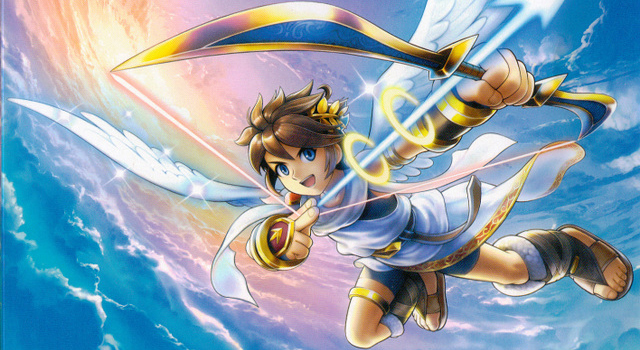Fire Emblem: Awakening — How Supportive

The biggest question surrounding the release of Fire Emblem: Awakening isn’t the question of whether the Fire Emblem franchise has returned to a dominant place among Nintendo’s IPs, but why it ever left in the first place. The last two console games, Path of Radiance and Radiant Dawn, were good and all (despite having the lowest sales in the franchise), but then Nintendo started handling the franchise confusingly. Despite how dominant the DS was on the market, it only received two remakes. The first one, Shadow Dragon, was considered archaic in design by many who played it. The latter, Heroes of Light and Shadow, never left Japan despite apparently being a much better game.
But this makes the release of Awakening stand out that much more, in what’s considered a return to form for a franchise strangely left in limbo for a little over five years. And fans let Nintendo know how much they missed it in the form of its sales, especially in Japan, where it became the best-selling FE game since the SNES days. And it was no slouch in America, either — it actually had the best first month sales for a game in the franchise so far. This meant it was more than old fans buying it: the game attracted plenty of new customers to the franchise because of the way it’s designed.
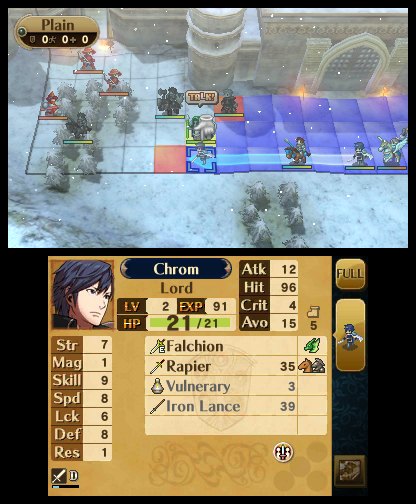
This should look familiar.
Awakening isn’t the first FE game to add option of “Classic” and “Casual” gameplay choices, but it’s the first where everyone took notice of it. One lets players play the game traditionally, while the latter gives them the option of avoiding the game’s form of “permadeath.” Characters killed in battle will still appear in cutscenes, but you won’t be able to use them in battle. But rolling Casual frees you of that stipulation, allowing your troops to fight another day despite falling in battle.
The choice of difficulty is best left to the individual player, but going Classic lends the game a sufficient amount of gripping tension, hammering home the authentic “battlefield” experience in casualties having severe repercussions. From said tension comes a greater sense of reward upon winning, showing that you’ve overcome a tough battle while leaving the entire party intact. Yet there are viable reasons for choosing the Casual difficulty level, for anyone fed up with losing a unit through no fault of their own — which can easily happen when an enemy lands a lucky critical hit none of your characters could have survived. It also allows you to take more risks in battle, to try out new strategies without the fear of losing a unit for good.
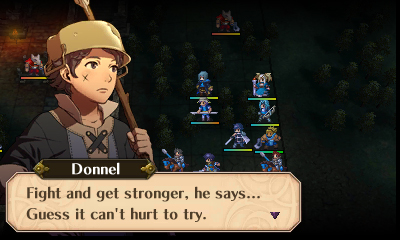
Casual makes it easier to level up characters that start at level 1, like Donnel here.
What’s great is that you can choose which difficulty you want, and don’t let anyone bully you into making the “right” choice, because there isn’t one. The choice in style spawned a number of arguments from fans about how people should be playing a game, which is ridiculous on all fronts. You’re capable of choosing which style suits you best, and you shouldn’t let anyone feel bad about the decision you’ve chosen.
Regardless of that, the main game plays like previous installments. The rock-paper-scissors mechanics remain intact for melee attacks, and long range techniques like arrows and magic still remain. But Awakening switches things up by letting you pair up two characters for combined attacks, adding a whole new dynamic of strategy — especially on higher difficulty levels. The more two specific characters are paired up, the more they’ll get along with each other in battle. And this will initiate support conversations.
Awakening takes place in the kingdom of Ylisse, and primarily follows the story of its prince, Chrom. But sharing the spotlight is your avatar, the Tactician, whose name is of your choosing. You may remember playing a Tactician previous FE games, but here, you’ll have the ability to customize their appearance (whose options are limited, but get the job done) and use them in battle. And you’ll want to, because they’re one of the most formidable allies you’ll get.
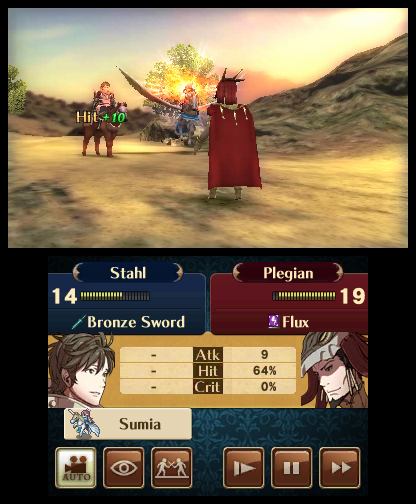
You’ll want to improve the relationships so characters like Stahl here stand a better chance.
The story unravels as you go from chapter to chapter, similar to previous FE games, but Awakening also offers plenty of side chapters. The point of them is to acquire additional characters for “The Shepherds,” the official name of the group consisting of Chrom and crew. After recruiting a number of these, you get the feeling that some are available to replace characters that might have been lost in battle due to permadeath, provided you have it on. Otherwise, you’ll be travelling with a gigantic crew.
The story starts off promising, but peters out in terms of quality halfway through without capitalizing on its potential. The last act, despite feeling ostensibly intriguing, ends up feeling very predictable. It’s clear the writers were focused on other matters, and those were the aforementioned support conversations. These consist of dialogues between two characters, initiated after you’ve paired them together often in battles. Some of them can even start relationships with each other, and have children that will join you in battle later on.
This is a big part of what will keep you coming back to the game constantly, and one of the reasons the “just one more battle” feeling is strong here, despite your originally-intended desire to shut the game off for the night. That’s even worse if it involves multiple characters you’re trying to pair together. It’s the first time us westerners get to experience it, and hopefully it’s a feature that will stick around for future installments.
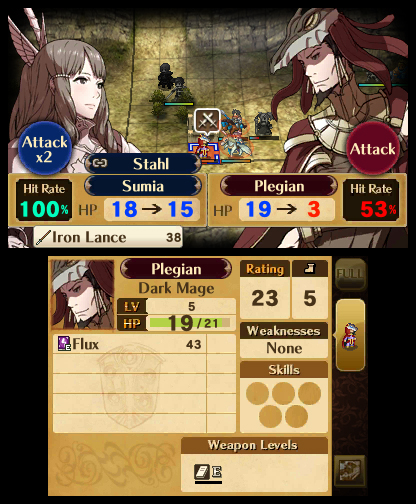
Thankfully, Sumia stands a good chance of taking this unit out.
Awakening’s soundtrack is provided by Yuka Tsujiyoko, Hiroki Morishita and Rei Kondoh, and it’s the best I’ve heard in the franchise thus far. Tsujiyoko has been with the franchise since the NES days, and is one of the most prominent female video game music composers around. She brings all of her experience here. Kondoh is a freelance composer who’s worked closely with Capcom over the last half-decade, making his first contribution with Nintendo, and hopefully he works with them more. There isn’t much about Morishita, but hopefully he sticks around too.
Like the Gamecube titles, this game also has voice acting. Unlike the Gamecube titles, it actually has quality voice acting. We’re living in a time where Nintendo of America is taking their English dubs seriously — a post Metroid: Other M world, if you will. Most of the English voice actors are veterans from the Tales and Persona games, which lends the dub a sense of familiarity. There isn’t much (there’s probably less than the GC games, especially Radiant Dawn), but what’s there is quality. Of course, if you don’t want that, there’s a Japanese voice option.
Awakening is akin to seeing an old friend that hasn’t been around in a while again. It’s a familiar experience, but it’s one of the most comforting around for fans of the franchise and strategy games in general. And that’s easily enough to give a high recommendation. Hopefully the franchise doesn’t take another 5+ year hiatus; though given its sales in Japan and America, that’s fortunately unlikely to happen.


